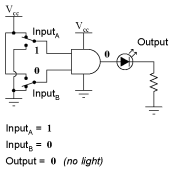| The ebook FEEE - Fundamentals of Electrical Engineering and Electronics is based on material originally written by T.R. Kuphaldt and various co-authors. For more information please read the copyright pages. |

|

Home  Digital Digital  Logic Gates Logic Gates  Multiple-input gates Multiple-input gates  AND gate AND gate |
|






|
|
|
AND gateOne of the easiest multiple-input gates to understand is the AND gate, so-called because the output of this gate will be "high" (1) if and only if all inputs (first input and the second input and . . .) are "high" (1). If any input(s) are "low" (0), the output is guaranteed to be in a "low" state as well.
In case you might have been wondering, AND gates are made with more than three inputs, but this is less common than the simple two-input variety. A two-input AND gate's truth table looks like this:
What this truth table means in practical terms is shown in the following sequence of illustrations, with the 2-input AND gate subjected to all possibilities of input logic levels. An LED (Light-Emitting Diode) provides visual indication of the output logic level:
It is only with all inputs raised to "high" logic levels that the AND gate's output goes "high," thus energizing the LED for only one out of the four input combination states.
|
|
Home  Digital Digital  Logic Gates Logic Gates  Multiple-input gates Multiple-input gates  AND gate AND gate |
|
Last Update: 2010-11-19







